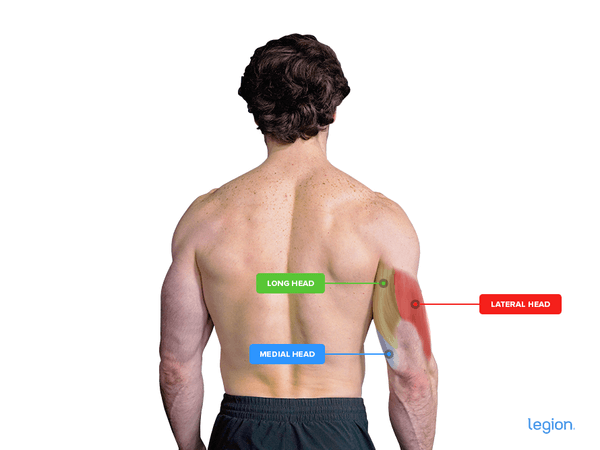The JM press is a unique triceps exercise invented by esteemed powerlifter JM Blakley.
It’s ideal for those looking to build impressive pressing strength because it allows you to continue training your triceps with heavy weights even when your chest and shoulders are beaten up from benching.
In this article, you’ll learn what the JM press is, the difference between the JfM press vs. the skull crusher, a step-by-step guide on how to JM press with proper form, the exercise’s benefits, which muscles it works, common mistakes and how to fix them, the best variations and alternatives, and more.
What Is A JM Press?
The JM press is a close-grip bench press and skullcrusher hybrid that primarily trains the triceps.
World-record-breaking powerlifter JM Blakley invented the exercise to continue strengthening his triceps when his chest and shoulders were bushed from benching.
Barbell JM Press vs. Skull Crusher
The main difference between the barbell JM press vs. the skull crusher is that in the JM press, you bend your wrists and elbows to lower the bar to your throat before pressing the weight up.
Conversely, in the skull crusher, you only bend your elbows to lower the bar to your forehead, then straighten your elbows to return to the starting position.
This distinction means the JM press is more like the close-grip bench press, and the skull crusher is more like the triceps extension.
Since both exercises complement each other, there’s no reason to think in terms of JM press vs. skull crusher. Instead, it makes sense to include both in your training, alternating between them every few months.
How to JM Press with Proper Form
1. Set up.
Lie on a bench so the top of your head is under the bar, then tuck your shoulder blades down and squeeze them together.
Grab the bar with your hands about 15-to-18 inches apart, plant your feet on the ground about shoulder-width apart, and unrack the bar. While keeping your arms locked, move the bar directly over your upper chest.
2. Descend
Bend your elbows and lower the bar toward your throat, flaring your elbows at 45 degrees relative to your torso.
Keep your elbows in front of your torso and roll your wrists forward so that your thumbs point toward the ceiling throughout the entire range of motion. Continue lowering the bar until your forearms and biceps touch.
3. Press
Reverse the movement and return to the starting position.
JM Press: Benefits
1. It builds bigger, stronger triceps.
The JM press trains the triceps through a full range of motion and allows you to train with heavy loads, making it ideal for building big, strong triceps.
2. It helps boost your bench press performance.
The stronger your triceps are, the easier it is to “lock out” the bench press.
The JM press is a boon for bench press performance because it’s an excellent exercise for strengthening your triceps.
3. It isolates your triceps.
Many weightlifters find that their pecs and delts are fried after a few sets of bench press, but their triceps could handle a couple more.
The barbell JM press allows you to continue training your triceps after your chest and shoulders are tired, ensuring you can train your tris with the volume they need to grow and become stronger without your other ”pushing” muscles becoming a limiting factor.
JM Press: Muscles Worked
The main muscles worked by the JM Press are the triceps.
Here’s how they look on your body:

Common Barbell JM Press Mistakes
1. Using too much weight.
Many new to JM presses load the bar with weights they typically bench. There are two reasons this is problematic:
- The JM press is a unique movement that takes practice. Lifting too much weight before you’ve developed the necessary coordination and strength can be dangerous, especially since you’re holding a loaded barbell over your throat.
- JM presses place stress on your elbows. If you try to handle too much weight too quickly, you’ll likely run into elbow pain.
The fix is simple: start light and progress slowly.
2. Dropping your elbows.
To emphasize your triceps, you must keep your elbows in front of your torso as you lower the bar. If they drop to your sides or below, the tension shifts to your shoulders, negating the exercise’s benefit.
3. Gripping too closely.
You should take a narrower grip for the JM press than the regular bench press, but it shouldn’t be so narrow that balancing and pressing the bar is challenging. Placing your hands 15-to-18 inches apart works best for most.
The Best Barbell JM Press Variations and Alternatives
1. Smith Machine JM Press
The Smith machine JM Press probably isn’t as effective at developing your triceps as the barbell variation because your muscles don’t have to work as hard to stabilize the weight. Nevertheless, it’s a workable alternative if you don’t have access to a barbell, are new to weightlifting, or don’t want to do the barbell version.
2. Dumbbell JM Press
In the dumbbell JM press, both sides of your body must lift the same weight independently, helping you find and fix muscle and strength imbalances. However, the dumbbell JM press is also less stable than the barbell JM press, which limits how much weight you can lift and negates some of the exercise’s muscle and strength-building potential.
3. Close-Grip Bench Press
The close-grip bench press lets you train your pushing muscles with heavy weights and progress regularly, making it excellent for building triceps size and strength and a worthy alternative to the JM press.










